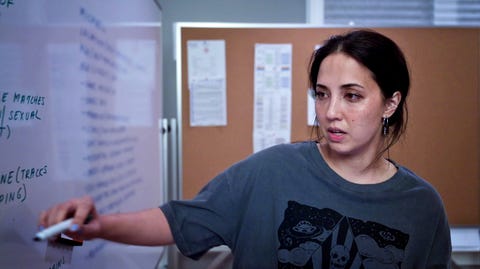Fashion
This 38-Year-Old Mom Disguises Herself as a Teen Girl to Catch Online Predators
Published
3 years agoon
By
Terry Power
Courtesy discovery+
Undercover Underage, a new docuseries from discovery+, follows 38-year-old mom of three Roo Powell as she dons disguises to take down dangerous predators. With help from her team at SOSA (Safe from Online Sex Abuse), Powell uses wigs, colored contacts, and fake braces to physically transform into a 15-year-old girl and catch online predators looking to groom young girls. Once an adult makes contact with her “decoy” character, SOSA’s crew of investigators work tirelessly to gather bits of information about the perpetrator—complicated work that is often extremely dangerous. If and when a crime is committed, SOSA turns over their findings to law enforcement.
Now available to stream, Undercover Underage features several real-life stings led by Powell. Below, in her own words, the child activist—and amateur actor—on why she’s dedicated her life to preventing the exploitation of teens online.
Flori is 15 years old. She is half white, half Filipina, with braces and wavy brown hair. She lives with her mom, who works late nights at a hospital. Her dad hasn’t been in the picture since he moved out of state with his new family.
She grew up Catholic, likes to go on runs, and occasionally plays the piano. Her blue-walled room is decorated with a tapestry depicting the moon phases. Twinkly lights hang from the ceiling. Notebooks and homework clutter her writing desk, and pages ripped from magazines are taped to the wall. She posts videos to TikTok and selfies to Instagram.
By all appearances, Flori is a typical teenager. Only she doesn’t really exist. I am Flori—or rather, I embody Flori to catch online predators.

Courtesy discovery+

Courtesy discovery+
Technology is a wonderful thing. But it’s also an avenue for child predators. In 2020, I formed the nonprofit Safe From Online Sex Abuse (SOSA). We work to reduce the amount of online exploitation by identifying dangerous pockets of the Internet, speaking at schools, and encouraging state legislators to raise the age of consent. We also help law enforcement track down offenders by using fictitious underage characters like Flori. We call them “decoys.”
One question I get a lot is whether I am somehow exploiting these perpetrators. We let the predators drive the conversation by taking a hands-off approach. We tell them at the outset that we are underage. We also do a lot of reminders, like “I’m coming home from school,” or “I just did my algebra homework,” or “I wish I was old enough to drive.” We offer off-ramps, too, telling them, “We don’t have to meet if you don’t want to,” or “Are you sure you want to be talking to me and not someone your own age?”

Courtesy discovery+
What we do is really different from Chris Hansen’s To Catch a Predator. This isn’t some game of gotcha. When I am Flori or any of the other decoys, my goal is to identify perpetrators illegally interacting with underage kids. If I can do that successfully, the information goes right to law enforcement, who can either do an independent investigation, take over my accounts and communicate as our decoy, or partner with us to catch the predator.
We have a rolling staff at SOSA to help make our characters more realistic. Matt takes and edits pictures that we send to the people who contact us. Shelby has unique knowledge of niche parts of the Internet, and does a lot of our work on social media. Avalon helps build the decoys to make them believable, like determining Flori’s astrological sign, where was she born, and what her favorite hobbies are.

Courtesy discovery+

Courtesy discovery+
We all work from a big rental house with four bedrooms decorated to match each decoy’s personality. We set-dress two bathrooms, and use the kitchen as needed. Wigs, colored contacts, fake braces, and clothes are stored in a closet. The living room acts as our “situation” room, where we do research and plan “sprints,” as we call them, to identify perpetrators.
At SOSA, we’re interested in detecting patterns around how predators target children. What we’ve found is that they tend to start by asking about parental oversight. We’ll be communicating with an ACM (or an “adult contacting a minor”) and right away they say, “Tell me about your dad.”
I’m Asian-American, and some of our decoys are Asian, so it’s been really interesting to see how the fetishization and dehumanization of Asian girls plays into online predation—so does socioeconomic status. If a girl is looking for money, there are adults who will say, “I’ll send you $200 if you text me X, Y, Z, or if you get on a video chat.” It’s not hard to see how attractive that offer is to someone in financial need.

Courtesy discovery+
One time, we had an abusive perpetrator block us after reaching out to one of our decoys on Reddit for material for his own self gratification. I was so irritated we didn’t find out who he was was before losing communication, because this was clearly not his first rodeo.
About a month later, we checked the DMs of a different decoy and he just so happened to reach out. We were like, holy shit. First of all, what are the odds? Second of all, how often does he do this? And third of all, we now have another opportunity to find out his identity. He’d already seen me as one decoy, so we threw together a very quick new persona with glasses, blonde hair, and red lipstick. Through that second decoy, we were able to identify him and send his information to law enforcement.

Courtesy discovery+

Courtesy discovery+
The conversations I have with predators can take a toll, especially the ones over video. One guy was very clear about his intentions and really aggressive. I had to pretend like I was enjoying what he was doing while video chatting. He kept asking me to remove by blouse, so in order to placate him I spun the phone camera around so he could see my legs.
There are other times when a perpetrator will do something really heinous, but it’s not quite breaking the law. In some states, it’s not illegal to message an 11-year-old and ask for photos of her feet so you can gratify yourself. It’s creepy, it’s wrong, it’s abusive—but it’s not illegal. Many of these perpetrators know what the law is, so they dance around it. It doesn’t have to be illegal to be abusive, so there’s nothing you can do. Law enforcement can’t pursue it because no law has actually been broken.

Courtesy discovery+
I compartmentalize what I do by keeping my professional and personal lives separate. I don’t have pictures of my kids on my desk, because I don’t want to see their faces while I’m doing this kind of work. I use a different phone to text with perpetrators, because I don’t want to get a dick pic on the same phone I’m using to take pictures of my child’s sporting event. Dick pics are ten-a-penny for me. At this point, the number of dick pics I’ve seen is in the four digits. If there was a such a thing as eye bleach, I would invest.
I have a therapist. I keep a weighted blanket on set. I do yoga and meditate. At night, I turn on Planet Earth on mute and listen to violin sonatas. If I have to work late, I don’t go home. I stay at the house and crash on one of the decoy’s beds.
One of the hardest parts about this job is not knowing what happens after we report someone to law enforcement. Sometimes we don’t know what happens with a case, or we find out about an arrest because we see it in the newspaper. It makes it hard to quantify how many predators we’ve helped catch, but I have passed along hundreds of cases. What keeps me going is knowing this is happening to me and not a real child.
What we do isn’t the end, it’s the means. We all need to come together to find paths to rehabilitation for would-be perpetrators, change legislation to raise the age of consent, introduce empathy-led education in schools, and help parents support their kids.
This interview has been lightly edited and condensed for clarity.
Staff Writer
Rose is a Staff Writer at ELLE covering culture, news, and women’s issues.
You may like
-


Why watermarking AI-generated content won’t guarantee trust online
-


China is escalating its war on kids’ screen time
-


Teen Basketball Player Suffers Rare Spinal Cord Stroke While Stretching
-


Experts Worry More Dogs Could Catch Parvovirus This Season
-


30 Surprising Health Issues That May Catch You Off Guard After Turning 30
-


Check For Breast Cancer Signs: Mom Issues Warning After Pink Breast Milk Leads To Shocking Diagnosis
Fashion
Jennifer Lopez Joined Ben Affleck In L.A. With Kids For Thanksgiving
Published
3 years agoon
26 November 2021By
Terry Power
On Wednesday night, Jennifer Lopez arrived in Los Angeles with her 13-year-old twins Max and Emme. The family was likely there to join Lopez’s boyfriend, Ben Affleck, for the Thanksgiving holiday. Lopez recently returned from the much colder climate of British Columbia, Canada, where she was filming her latest project, The Mother.
J. Lo touched down in her private jet wearing a teddy fur coat from Coach’s Autumn/Winter 2019 collection, and a pair of Ugg boots. Classic airplane outfit, celebrity style. Lopez and Affleck originally dated in 2002 and broke up in 2004. Their romance was rekindled earlier this year, soon after Lopez ended her relationship with baseball player Alex Rodriguez. The new couple went official in July, while celebrating Lopez’s 52nd birthday abroad.
Affleck’s most recent relationship with Ana de Armas ended in January after about a year together. He had divorced ex-wife Jennifer Garner in 2015 after being married for almost a decade. Garner and Affleck had three daughters, Violet, Seraphina, and Sam.
Before traveling back to the U.S., Lopez posted a story to Instagram Reels about how grateful she was to be headed home.
“Hey everybody, it’s my last day here shooting on The Mother out in Smithers in the snow, it’s been beautiful, but tonight I’m on my way home,” she said, as she walked through the wild landscape in a black coat and beanie.
“I’m so excited for Thanksgiving! I hope everybody has an amazing weekend with their families and their loved ones, there’s so much to be grateful for this year. I’m on my way!”
This is the first major holiday of the year since Lopez and Affleck reunited, so it’s likely to be a big one for both families.
This content is created and maintained by a third party, and imported onto this page to help users provide their email addresses. You may be able to find more information about this and similar content at piano.io
Fashion
Everlane’s Black Friday Sale is Packed With Winter Essentials
Published
3 years agoon
26 November 2021By
Terry Power
Courtesy
This is not a drill: Everlane just kicked off its Black Friday sale. Now through Monday, November 29, the direct-to-consumer brand is offering 20 to 40% off its cozy sweaters, minimalist activewear, and popular jeans. If you’re not super familiar with Everlane, let me spell it out for you: this is a big deal.
The e-tailer might be known for making sustainable, ethically made clothes and accessories at a fair, affordable price, but Everlane rarely has sales beyond its Choose What You Pay section. So, if you want to stock up on cute basics for less, now’s your time to shop.
And, in true Everlane fashion, the brand is taking this opportunity to give back. Everlane is partnering with Rodale Institute and help U.S. farmers transition their farmland to regenerative organic—and donating $15 per order to the cause. A great sale that gives back? I’m sold.
But, hurry! These deals are going to sell out fast, so you won’t want to waste any time filling your e-cart.
Advertisement – Continue Reading Below
1
The Cloud Turtleneck
$150 $105 (30% off)
Sweater weather is officially here, so why not pick up a few fresh layers? This turtleneck is the S’s: snuggly, stylish, and on sale.
2
The Authentic Stretch High-Rise Skinny Jeans
everlane
$78 $58 (25% off)
Looking for a great pair of jeans, minus the markup? Everlane’s classic skinny style is not only super stretchy, but it’ll look good with everything from chunky sweaters to silky blouses.
3
The ReNew Teddy Slippers
everlane
$65 $39 (40% off)
Why limit the shearling trend to the upper half of your body? These plush slippers will give even your most worn-in sweats a stylish edge.
4
The Chunky Cardigan
everlane
$110 $77 (30% off)
Sure, this may not be the cardigan Taylor Swift was talking about. But, with an exaggerated collar and ribbed finish, this style would definitely score top marks from the singer herself.
5
The Canvas Utility Boots
everlane
$115 $59 (40% off)
Brave the cold weather in style with Everlane’s chic boots. The canvas uppers and thick sole make these an ideal, all-weather option.
6
The Lofty-Knit Henley
everlane
$150 $105 (30% off)
Made with a nubby blend of merino wool, alpaca, and recycled nylon, this henley is perfect for a cozy night in, yet stylish enough to wear in public.
7
The Perform Bike Shorts
everlane
$45 $22 (51% off)
No, you can never have too many stretchy pants. Everlane’s bike shorts ooze major Lady Di vibes — for under $25, no less.
8
The ReLeather Court Sneakers
everlane
$110 $66 (40% off)
Made with recycled leather, these refresh sneakers will serve up major curb appeal — and Mother Nature’s seal of approval.
9
The Field Dress
everlane
$100 $60 (40% off)
Found: a fun, flouncy frock you can wear year-round. For a wintry take, pair with opaque tights and your favorite chunky boots.
10
The Cozy-Stretch Wide-Leg Sweatpants
everlane
$150 $75 (50% off)
With a straight-legged silhouette and wool material, it’s safe to say these are the chicest sweatpants we’ve ever seen. To sweeten an already enticing offer, this pair is half off.
11
The Organic Cotton Flannel Popover
$80 $56 (30% off)
Everlane reimagined the traditional flannel with a cropped silhouette, voluminous sleeves, and a slew of minimalist colors.
12
The Studio Bag
everlane
$275 $192 (30% off)
Large enough to fit all your essentials, but not too big that it’ll weigh you down, Everlane’s Studio Bag is the perfect everyday purse.
13
The ReNew Long Liner
everlane
$158 $118 (25% off)
House Stark was right: winter really is coming. Made with recycled materials, this liner is a great layering piece that’s considerably chicer than the yesteryear’s Michelin Man-worthy parkas.
14
The Felted Merino Beanie
everlane
$50 $30 (40% off)
All set on clothes? Pick up this cheery beanie, which is 40% off its original price.
Kelsey Mulvey is a freelance lifestyle journalist, who covers shopping and deals for Marie Claire, Women’s Health, and Men’s Health, among others.
This content is created and maintained by a third party, and imported onto this page to help users provide their email addresses. You may be able to find more information about this and similar content at piano.io
Advertisement – Continue Reading Below
Fashion
29 Winter Fragrances That Exude Main Character Energy
Published
3 years agoon
26 November 2021By
Terry Power
29 Winter Fragrances That Exude Main Character Energy
